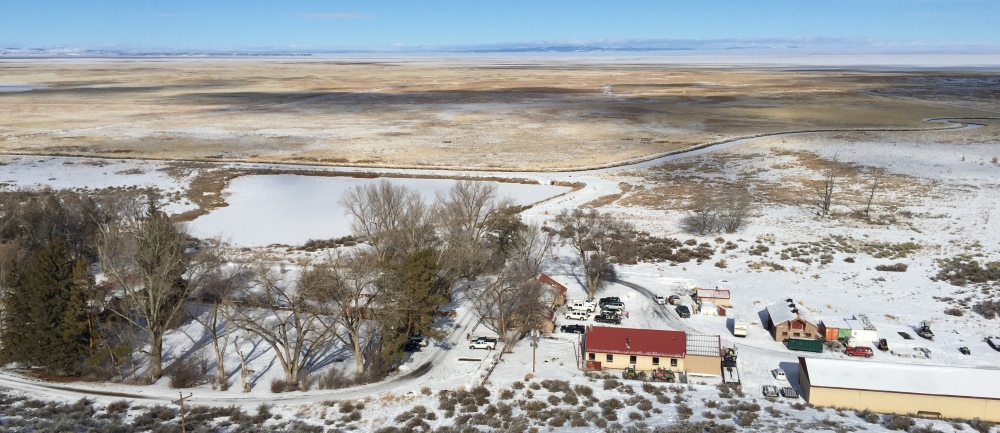Thousands of archaeological artifacts – and maps detailing where more can be found – are kept inside the national wildlife refuge buildings currently being held by an armed group of protesters angry over federal land policy.
Ryan Bundy, one of the leaders of the group occupying the Malheur National Wildlife Refuge in southeastern Oregon, says they have no real interest in the antiquities. Still, their access to the artifacts and maps has some worried that looters could take advantage of the situation.
“There’s a huge market for artifacts, especially artifacts that have provenance, where you can identify where they came from,” said Carla Burnside, the U.S. Fish and Wildlife Service’s refuge archaeologist.
More than 300 recorded prehistoric sites are scattered across the refuge, including burial grounds, ancient villages and petroglyphs. Some of the artifacts – including spears, stone tools, woven baskets and beads – date back 9,800 years.
About 7,000 artifacts and samples from the refuge are kept at a museum in Eugene, Oregon. But 4,000 more are kept at the refuge for research.
Only Burnside has a key to the room containing the artifacts and the maps. She’s since seen pictures of the occupiers in her office, adjacent to the room where the artifacts are stored. The group has been looking through government files at the site, but it is unclear if they’ve gone through the room with the artifacts. Bundy told The Associated Press that he’s seen the artifacts and lots of maps, but he didn’t know what the maps illustrated.
NOT INTERESTED IN ARTIFACTS
The artifacts and maps are legally protected by the 1979 Archaeological Resources Protection Act and other federal laws.
Bundy said they’re not interested in the artifacts and would turn them over to the Burns Paiute Tribe, if asked.
“If the Native Americans want those, then we’d be delighted to give them to them,” he said.
He said he didn’t think it was likely that anyone would use the maps to loot the site.
“We haven’t really been thinking along those lines,” Bundy said.
Removing artifacts from federal property without a permit is illegal. Scientists are also worried about unintentional damage that could be done to the prehistoric sites by cattle, vehicles and heavy equipment.
The group at the ranch has driven road graders and other large construction equipment around the refuge headquarters buildings, but Bundy said they haven’t used the machinery to move any earth. He wouldn’t rule out that possibility, however.
CONCERN FOR PRESERVATION
In 2014, Ryan Bundy and supporters of the Bundy family rode ATVs on federal land closed to motorized vehicles in Utah as part of a protest. Their route took them along an illegal trail that crossed through Native American archaeological sites.
While well-known petroglyphs or other prehistoric sites are occasionally publicized for public viewing, federal land managers often go to great lengths to keep such locations secret when they can’t be safely protected from vandals and looters.
Looting has long been a problem at the refuge, with the first documented instance recorded in 1979, according to the Fish and Wildlife Service’s comprehensive conservation plan.
“It’s a huge problem in Oregon, especially in the southeast portion of the state,” said Dennis Griffin, the state’s archaeologist. “More often than not, when they are caught, it’s connected to drug running or seeking quick money on eBay.”
An online search of “great basin artifacts for sale” yields arrowheads, stone pestles and other items, many priced at hundreds of dollars each.
Burnside said the artifacts are part of the ancestry of the Burns Paiute Tribe and are priceless to science.
The tribe works extensively with federal officials on the archeology projects. Tribe officials didn’t return multiple phone messages requesting comment.
“Their history is being hijacked by these people,” said Donald Grayson, an anthropologist and archeology expert at the University of Washington.
Copy the Story LinkSend questions/comments to the editors.



Success. Please wait for the page to reload. If the page does not reload within 5 seconds, please refresh the page.
Enter your email and password to access comments.
Hi, to comment on stories you must . This profile is in addition to your subscription and website login.
Already have a commenting profile? .
Invalid username/password.
Please check your email to confirm and complete your registration.
Only subscribers are eligible to post comments. Please subscribe or login first for digital access. Here’s why.
Use the form below to reset your password. When you've submitted your account email, we will send an email with a reset code.